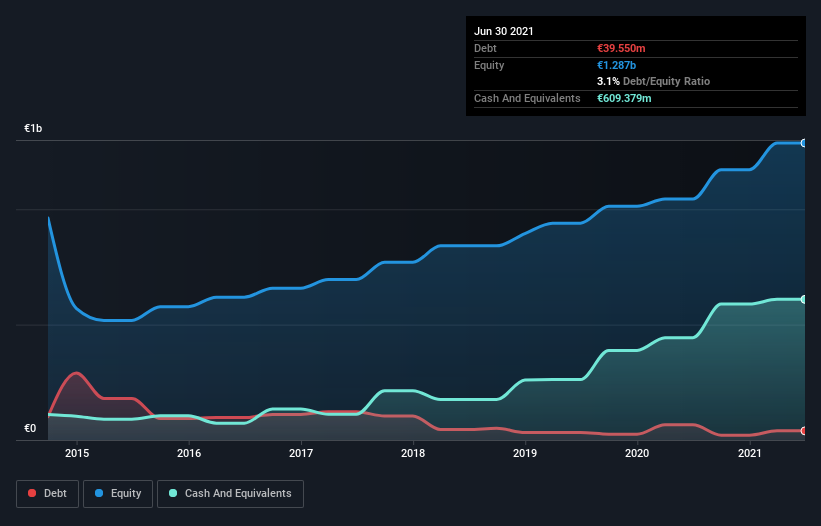
The external fund manager backed by Berkshire Hathaway's Charlie Munger, Li Lu, makes no bones about it when he says 'The biggest investment risk is not the volatility of prices, but whether you will suffer a permanent loss of capital.' So it seems the smart money knows that debt - which is usually involved in bankruptcies - is a very important factor, when you assess how risky a company is. As with many other companies Somfy SA (EPA:SO) makes use of debt. But the more important question is: how much risk is that debt creating?
Why Does Debt Bring Risk?
Generally speaking, debt only becomes a real problem when a company can't easily pay it off, either by raising capital or with its own cash flow. In the worst case scenario, a company can go bankrupt if it cannot pay its creditors. However, a more common (but still painful) scenario is that it has to raise new equity capital at a low price, thus permanently diluting shareholders. Of course, the upside of debt is that it often represents cheap capital, especially when it replaces dilution in a company with the ability to reinvest at high rates of return. The first step when considering a company's debt levels is to consider its cash and debt together.
See our latest analysis for Somfy
How Much Debt Does Somfy Carry?
The image below, which you can click on for greater detail, shows that Somfy had debt of €39.6m at the end of June 2021, a reduction from €66.0m over a year. But on the other hand it also has €609.4m in cash, leading to a €569.8m net cash position.

A Look At Somfy's Liabilities
We can see from the most recent balance sheet that Somfy had liabilities of €289.4m falling due within a year, and liabilities of €133.4m due beyond that. Offsetting these obligations, it had cash of €609.4m as well as receivables valued at €240.7m due within 12 months. So it can boast €427.3m more liquid assets than total liabilities.
This short term liquidity is a sign that Somfy could probably pay off its debt with ease, as its balance sheet is far from stretched. Succinctly put, Somfy boasts net cash, so it's fair to say it does not have a heavy debt load!
On top of that, Somfy grew its EBIT by 93% over the last twelve months, and that growth will make it easier to handle its debt. When analysing debt levels, the balance sheet is the obvious place to start. But it is future earnings, more than anything, that will determine Somfy's ability to maintain a healthy balance sheet going forward. So if you want to see what the professionals think, you might find this free report on analyst profit forecasts to be interesting.
Finally, a company can only pay off debt with cold hard cash, not accounting profits. While Somfy has net cash on its balance sheet, it's still worth taking a look at its ability to convert earnings before interest and tax (EBIT) to free cash flow, to help us understand how quickly it is building (or eroding) that cash balance. During the last three years, Somfy generated free cash flow amounting to a very robust 91% of its EBIT, more than we'd expect. That puts it in a very strong position to pay down debt.
Summing up
While it is always sensible to investigate a company's debt, in this case Somfy has €569.8m in net cash and a decent-looking balance sheet. And it impressed us with free cash flow of €316m, being 91% of its EBIT. So we don't think Somfy's use of debt is risky. Over time, share prices tend to follow earnings per share, so if you're interested in Somfy, you may well want to click here to check an interactive graph of its earnings per share history.
At the end of the day, it's often better to focus on companies that are free from net debt. You can access our special list of such companies (all with a track record of profit growth). It's free.
If you decide to trade Somfy, use the lowest-cost* platform that is rated #1 Overall by Barron’s, Interactive Brokers. Trade stocks, options, futures, forex, bonds and funds on 135 markets, all from a single integrated account. Promoted
New: Manage All Your Stock Portfolios in One Place
We've created the ultimate portfolio companion for stock investors, and it's free.
• Connect an unlimited number of Portfolios and see your total in one currency
• Be alerted to new Warning Signs or Risks via email or mobile
• Track the Fair Value of your stocks
This article by Simply Wall St is general in nature. We provide commentary based on historical data and analyst forecasts only using an unbiased methodology and our articles are not intended to be financial advice. It does not constitute a recommendation to buy or sell any stock, and does not take account of your objectives, or your financial situation. We aim to bring you long-term focused analysis driven by fundamental data. Note that our analysis may not factor in the latest price-sensitive company announcements or qualitative material. Simply Wall St has no position in any stocks mentioned.
*Interactive Brokers Rated Lowest Cost Broker by StockBrokers.com Annual Online Review 2020
Have feedback on this article? Concerned about the content? Get in touch with us directly. Alternatively, email editorial-team (at) simplywallst.com.
About ENXTPA:SO
Somfy
Somfy SA manufactures and sells automatic controls for openings and closures in homes and buildings.
Flawless balance sheet average dividend payer.
Similar Companies
Market Insights
Community Narratives




